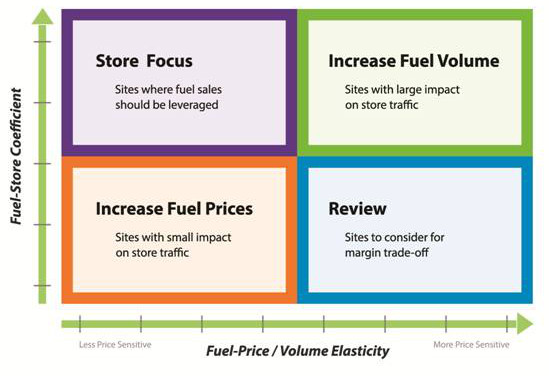How to Convert Pump Sales to In-Store Sales
 According to recent research conducted by NACS, the Association for Convenience & Fuel Retailing, 63 percent of gas customers go on to spend an average of $4.82 each in the store following their fill-up. That’s an 11-percent increase vs. 2012. On the surface, this sounds like an encouraging trend, but what about the remaining 37 percent who are not converted to in-store shoppers? Are potential sales being left on the table? What role does gas play in increasing store traffic?
According to recent research conducted by NACS, the Association for Convenience & Fuel Retailing, 63 percent of gas customers go on to spend an average of $4.82 each in the store following their fill-up. That’s an 11-percent increase vs. 2012. On the surface, this sounds like an encouraging trend, but what about the remaining 37 percent who are not converted to in-store shoppers? Are potential sales being left on the table? What role does gas play in increasing store traffic?
Here’s what we know. Gas is the No. 1 category. It contributes 71 percent of sales and one-third of the gross margin dollars at a convenience store. Understanding the role gas plays in driving the performance of other categories is a key to optimizing overall site performance.
This begs answers to two fundamental questions:
- At which sites does it pay to increase store traffic by attracting more gas customers?
- How do retailers get more gas customers inside the store?
Fortunately, there are answers to both.
INCREASING STORE DEMAND
Let’s address the first question. Retailers intuitively know that the relationship between gas and store sales varies by site, with some sites having a strong relationship and others almost none. Knowing where store sales will benefit from higher gas volumes is critical to avoid giving away gas margin needlessly. Why try to increase gas volumes by lowering gas prices if only a few gas customers pay a visit to your store?
Proven techniques have been created that allow gas retailers to segment sites in order to identify those where increasing gas customers translates to more store business. These techniques involve categorizing sites on two important measures: the strength of the fuel-store relationship and the ability to positively impact gas volume (the fuel price-volume sensitivity). The result is a target list of sites where adjusting gas price tactics will have a positive overall impact on performance by driving higher store sales. The figure below illustrates the typical output of this type of analysis.

As shown in this figure, sites in the upper-right quadrant are the ones where increased gas sales will translate to increased store business. Growing gallons by carefully lowering gas prices will result in higher store traffic and store sales. How much do store sales increase? Recent case studies indicate that the average increase in store sales is 35 cents per extra gallon of gas. This means one extra customer filling a 15-gallon tank is worth around $5 in store sales. Factoring in the margin rates in the store and the reduction in gas price needed to drive additional volume results in more gross profit dollars overall.
How does this work in practice? Once the candidate sites have been identified, using the type of analysis shown above, the next challenge is to determine how many extra gas gallons can be generated and the price changes that will need to be made to deliver the extra gallons. This is the job of the gas pricing strategy, and it’s a balancing act between creating extra traffic to visit the store, but not so much traffic that the forecourt becomes overly busy and drives customers away.
A necessary component to determine the right prices to attract incremental gas customers is an understanding of the price-volume sensitivity at each site. This is often referred to as "price elasticity," a measure of how many incremental gallons will be earned for every penny change in price. These relationships are best delivered in a gas price model that includes the effects of competitor prices and takes into account the available demand in a given market. These types of models are available in a class of tools known as "Pricing Intelligence."
With a model of the price-volume dynamics in a market, a retailer can set a desired gas volume target and define the price limits within which they’re happy to operate. The Pricing Intelligence model will recommend daily gas prices that will meet the desired volume with minimal margin giveaway.
Finally, a reporting capability is needed that constantly analyzes gas volumes and store sales and shows whether the extra gallons are producing incremental store business. The same reporting capability can also alert operators if any adjustments are needed to gas volume targets or price limits based on competitor actions or underlying market demand. One major convenience store retailer experienced a per-store sales increase of approximately $5,000 per year, simply as a result of adjusting gas volume targets in favor of sites with higher gas-store conversion rates.
CONCLUSIONS
For many retailers, the primary source of store demand is the gas customer. With only 63 percent of gas customers subsequently visiting the store, there’s a significant untapped market to increase store sales. The first step in the journey to fueling store sales is to simply increase the number of “63-percenters” who visit your stores — but only at those sites where a healthy proportion of that demand naturally converts to store business.
Retailers that have successfully tried this have seen increases of nearly $5,000 per store per year.
Mark Hawtin is senior vice president of strategy and business development for KSS Fuels. He is responsible for product strategy, business development and global marketing. With 23 years of experience in the downstream energy sector, and the last 15 years in fuel and convenience retailing, he has a deep understanding of the industry in numerous geographic markets.
Editor's note: The opinions expressed in this column are the author’s and do not necessarily reflect the views of Convenience Store News.
